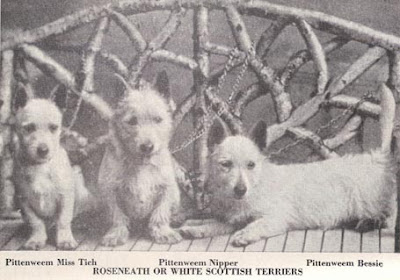Remember these whisky ads from 50-plus years ago? They graced the pages of most major magazines.
Black and white.
Salt and pepper.
Yin and Yang.
There's a natural partnership noted here, and it's not a coincidence. Not too long before the 1890s when this "Black and White" advertising campaign was initiated, these two now-distinct "breeds" were considered varieties of the SAME breed of dog. Black, white and sometimes wheaten and even brindle-colored terriers often appeared in the same litter.
Folks who lived in the wilds of Scotland needed hardy dogs capable of digging rabbits, rats and foxes out of burrows among the craggy rockpiles (known as "cairns") and under thorn bushes; places where bigger dogs would be unable to go. The small terriers were the result of this need. The word terrier comes from the Latin "terra" or earth. Terriers will dig furiously into burrows in search of their quarry. Sometimes they dig in so deeply that the hunter might have to pull them out by their stocky tail. Their harsh, shaggy coats keep them warm in the snowy winters and protect their skin from brambles. The eyebrows help to keep the soil out of the eyes when digging.
In the 1800's,the terriers of Scotland were a diverse lot of similar type. The dogs were long and low, rough-coated, and well suited to rout out foxes, badgers and martens from their dens.
The Scottish dog breeds that descended from the Aberdeen or Skye terrier of yesteryear are the modern Skye terrier, the Cairn Terrier, the West Highland White Terrier and the Scottish Terrier. These breeds have only formed over the past one hundred fifty or so years years as distinct breeds.
The Dandie Dinmont was another type of terrier known in Scotland, and likely shares some common ancestry with the other Scottish terrier breeds. Check the resemblance in this depiction of Guy Mannering in 1814; "Dandy Dinmont" with his terriers:
Any crossbreeding between these similar terrier varieties is strictly forbidden by the registering Kennel Clubs. According to Scottish Terrier historian Cindy Cooke, all today's Scottish Terriers descend from ONE common female ancestor. In the early 20th century, the gene pool was narrowed further down to just a handful of popular dogs.
And therein lies a very serious problem. The result of generations of inbreeding is a physical depression, characterized by shortened lifespan, decreased vigor and fertility, and increased susceptibility to autoimmune disease, infectious disease and cancer. There is also a propensity for recessive health problems to become entrenched in a breed through inbreeding, and the proscription against outcrossing to other groups of terriers assures that defects will continue to affect a large percentage of a breed's population.
But don't take my word for it: more in depth information is posted on the "Great Scots" blogpage:
http://tartanscottie.com/macblog/?p=58
Dog breeding is not a black and white activity. We should stop occasionally and ponder the nuances of those shades of grey.
More on history of the Scottish terrier breeds:
http://stcinc.org/learn.htm


Early terriers.
Terriers in the 1940's. Distinct yet remain very similar in physical appearance.















No comments:
Post a Comment